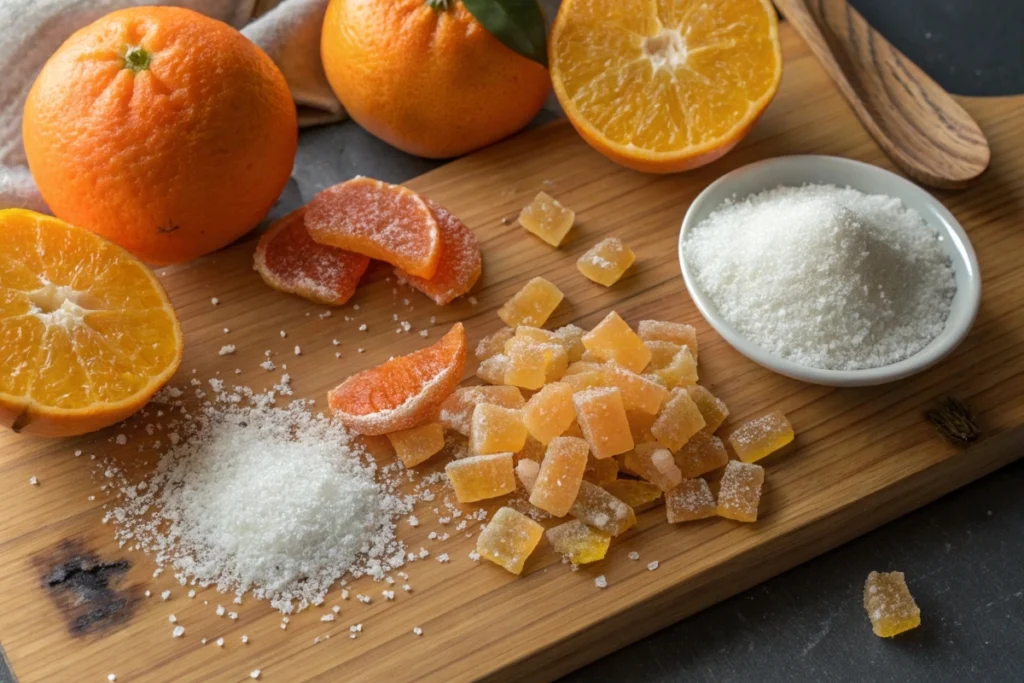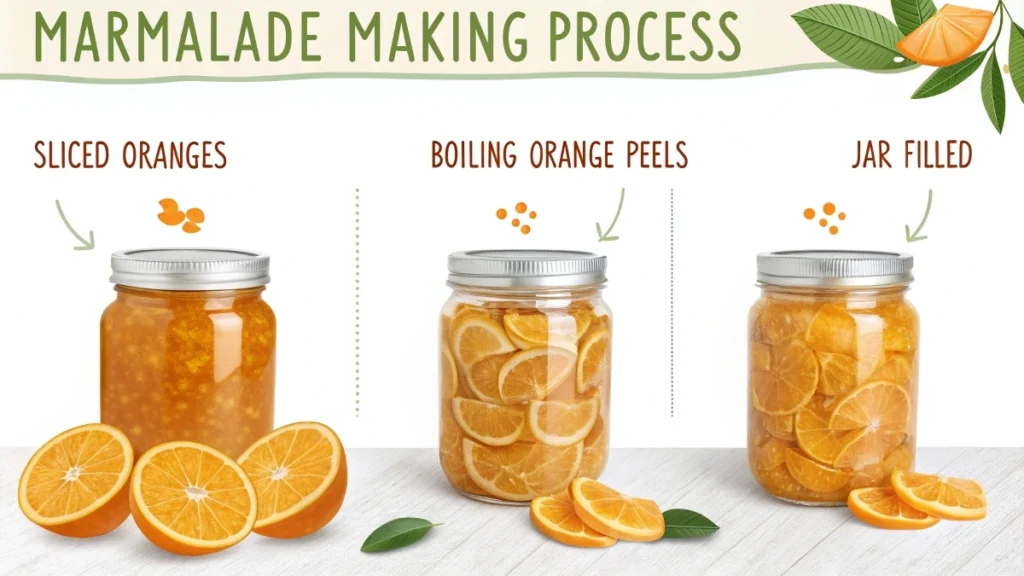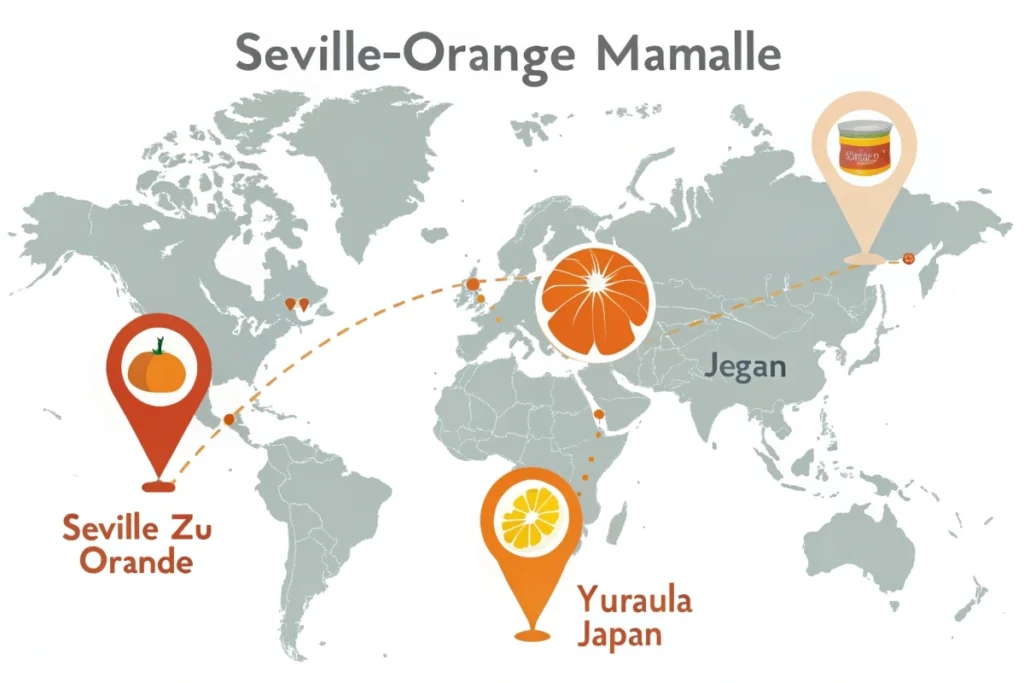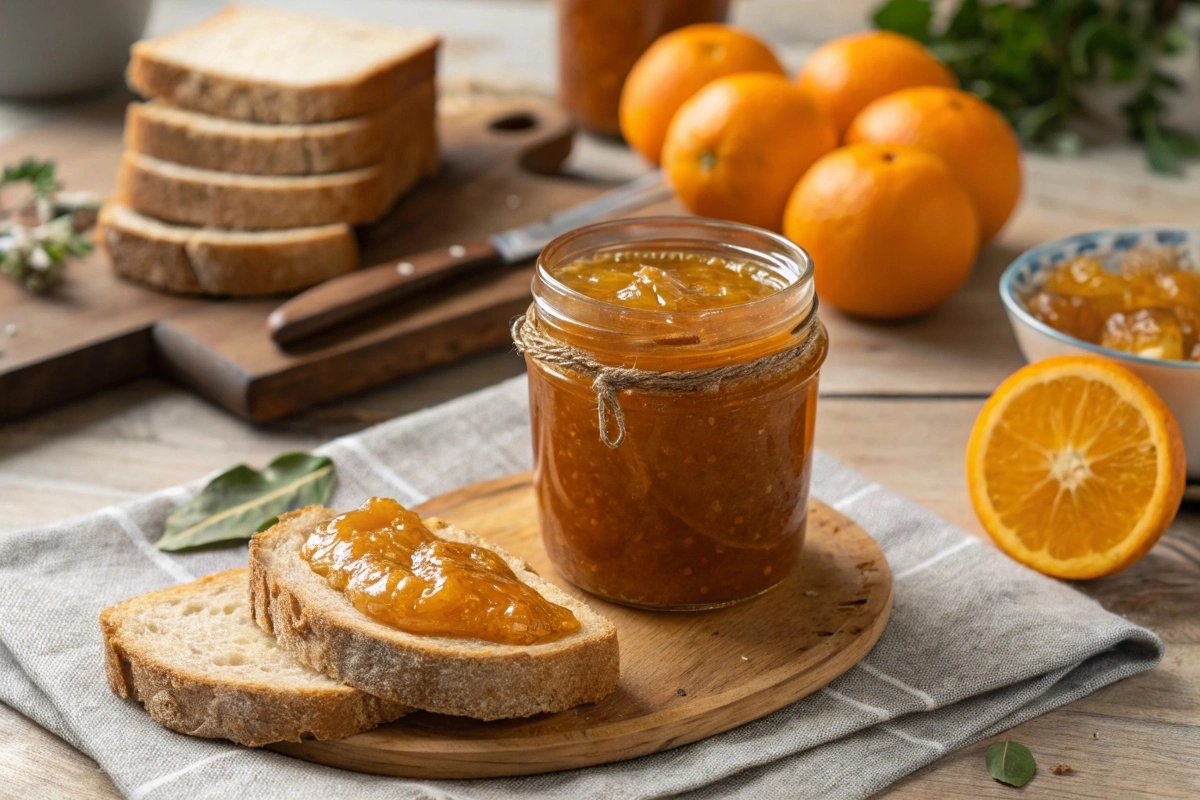What Flavor is Marmalade?
Marmalade is more than just a breakfast condiment—it’s a sweet, tangy, and slightly bitter spread made from citrus fruits that has captivated taste buds for centuries. But what flavor is marmalade exactly? This article delves into its unique flavor profile, exploring the interplay of sweetness, tanginess, and bitterness that makes marmalade stand out. We’ll also uncover its origins, variations around the world, and creative ways to enjoy this beloved spread.
Introduction to Marmalade – What Flavor is Marmalade?
What is Marmalade?
Marmalade is a fruit preserve, but not just any preserve—it’s a citrus spread made by boiling citrus juice and peel with sugar and water. The result? A semi-transparent, jelly-like spread that’s equal parts sweet, tangy, and bitter. Unlike regular jams or jellies, marmalade embraces bitterness, thanks to the citrus peel that gives it a unique edge.
Traditionally, oranges, particularly bitter Seville oranges, are the go-to choice for marmalade. However, variations using lemons, limes, and even grapefruits have gained popularity. Whether slathered on toast or used as a glaze, marmalade’s distinctive flavor has made it a breakfast staple and culinary favorite.
A Brief History of Marmalade
The origins of marmalade can be traced back to 16th-century Portugal, where “marmelada” referred to a quince paste. Over time, the recipe evolved as it traveled to Britain, where Seville oranges became the star ingredient. The British took a shine to the bitter-sweet concoction, making it a hallmark of their breakfast table.
Interestingly, marmalade has always been about balance—capturing the sharp tang of citrus, the sweetness of sugar, and the depth of bitterness from the peel. This citrus-based preserve has transcended cultures, earning a spot in pantries and cookbooks worldwide.
The Flavor Profile of Marmalade – What Flavor is Marmalade?
Core Ingredients that Define Marmalade’s Flavor
When it comes to defining what flavor is marmalade, the answer lies in its carefully chosen ingredients. Marmalade is typically crafted from citrus fruits—most commonly oranges—combined with sugar and water. The citrus peel plays a starring role, lending the spread its signature bitterness and texture. This combination of ingredients creates a delicate balance of sweetness, tanginess, and bitterness that sets marmalade apart from other fruit spreads.
Unlike jams, which rely on whole fruits, marmalade incorporates both the juice and peel. This unique preparation ensures that every bite delivers a burst of citrus-packed flavor with an underlying bitter complexity. Variations in citrus types—like grapefruits or limes—can subtly alter the flavor profile, offering everything from sharply tart to mildly sweet notes.
The Balance of Sweetness, Bitterness, and Tanginess
The magic of marmalade lies in its ability to blend contrasting flavors into a harmonious whole. Sweetness comes from sugar, while the citrus peel contributes bitterness, and the juice adds a bright tanginess. These elements work together to create a complex yet approachable taste.
For instance, Seville orange marmalade, known for its bold bitterness, is a quintessential choice for those who appreciate robust flavors. On the other hand, variations with mandarin oranges or clementines lean toward the sweeter side, appealing to milder palates. This interplay of flavors is why marmalade continues to captivate taste buds across the globe.
Comparison to Other Fruit Preserves: How Marmalade Stands Out
Compared to jams and jellies, marmalade’s inclusion of citrus peel gives it a distinctive edge. While jams often prioritize sweetness, marmalade embraces bitterness as a defining characteristic. Its versatility also makes it a favorite in savory dishes, where its tangy-sweet flavor can enhance meat glazes or salad dressings.
The next time someone asks, “What flavor is marmalade?”, think of it as a citrus medley that dances between sweet, tangy, and bitter—a flavor experience unlike any other.

The Flavor Profile of Marmalade – What Flavor is Marmalade?
Why Citrus is Key: Oranges, Lemons, and Grapefruits in Marmalade
Citrus fruits are the cornerstone of marmalade’s flavor. But why? It’s because these fruits have a natural balance of sweetness and acidity that’s ideal for making preserves. Oranges, particularly the bitter Seville variety, are prized for their strong, tangy flavor and fragrant peel.
However, marmalade isn’t limited to just oranges. Lemons bring a sharper tang, while grapefruits add a hint of floral bitterness. Each citrus fruit contributes its unique personality to the final product, ensuring that no two marmalades taste the same.
Exploring Popular Marmalade Variations: Clementine, Mandarin, and Lime
Over the years, marmalade makers have experimented with a range of citrus fruits to create new and exciting flavors. Clementine marmalade is sweeter and less bitter, perfect for those who prefer a milder spread. Mandarin marmalade, with its rich, fruity aroma, has a depth that feels indulgent.
For something more exotic, lime marmalade offers a zesty twist with a sharper tang. These variations highlight marmalade’s versatility and ability to adapt to different palates while maintaining its citrus-forward flavor profile.
How the Peel Adds to the Flavor Complexity
One of the most distinctive features of marmalade is the inclusion of citrus peel. The peel not only thickens the mixture but also contributes layers of bitterness and texture. As the peel cooks, its natural oils are released, infusing the spread with a bright, aromatic quality.
This unique use of peel is why marmalade has a more complex flavor compared to other fruit preserves. It’s also why the question, “What flavor is marmalade?” doesn’t have a simple answer—it’s a dynamic blend of citrus elements, sugar, and time-honored technique.
The Flavor Profile of Marmalade – What Flavor is Marmalade?
Traditional Techniques and Ingredients
Making marmalade at home isn’t just about creating a delicious spread—it’s a chance to connect with tradition. Classic marmalade recipes focus on simple ingredients: citrus fruits (like oranges or lemons), sugar, and water. Bitter Seville oranges are the most traditional choice due to their aromatic zest and robust flavor.
The process begins with slicing the fruit, including the peel, into thin strips. These are simmered with water to soften the peel and release essential oils, which lend marmalade its distinctive bitterness. Then, sugar is added, and the mixture is boiled until it reaches a gel-like consistency. Using a candy thermometer ensures you hit the perfect temperature for setting.
Modern Twists on Marmalade Recipes
Today, marmalade-making has become a playground for creativity. Home cooks often experiment with combinations like orange and ginger, lemon and lavender, or even lime and chili. Adjusting sugar levels or adding unique spices can personalize the flavor.
For those who shy away from bitterness, reducing the amount of citrus peel can yield a milder, sweeter spread. Alternatively, using fruits like clementines or tangerines creates a marmalade that’s naturally sweeter and less sharp.

Pro Tip: Check out other exciting recipes on Kamala Recipes for more culinary inspiration!
The Science of Marmalade’s Taste – What Flavor is Marmalade
How Cooking Methods Influence Flavor
The cooking process has a profound impact on the taste of marmalade. When citrus peel is boiled, it releases pectin, which thickens the spread, and essential oils, which add depth to the flavor. Longer cooking times intensify the bitterness of the peel, while shorter times preserve a fresher, tangier taste.
Interestingly, sugar doesn’t just sweeten marmalade; it also enhances its flavor by caramelizing slightly during boiling. This adds a warm, complex sweetness that offsets the sharpness of the citrus.
The Role of Sugar and Acid in Balancing Taste
Sugar and acid are the unsung heroes of marmalade. Citrus fruits are naturally acidic, giving marmalade its characteristic tang. Balancing this acidity with the right amount of sugar creates harmony in the spread. Too much sugar can mask the bold citrus-forward flavor, while too little can leave it overwhelmingly tart or bitter.
The interplay between sugar, acid, and bitterness is what makes marmalade’s flavor so intriguing. It’s why so many ask, “What flavor is marmalade?”—it’s an intricate blend that evolves with every bite.
Looking for more creative ideas? Browse other delightful recipes like: What is in a Multigrain Bagel? A Comprehensive Guide
Marmalade in Culinary Uses – What Flavor is Marmalade in Recipes?
Pairing Marmalade with Breakfast Dishes
Marmalade is a breakfast classic, often gracing slices of toast or English muffins. But its uses don’t stop there! Its sweet and tangy flavor pairs wonderfully with creamy spreads like butter or cream cheese, creating a delightful balance of richness and brightness.
Beyond toast, marmalade is a fantastic addition to pancakes, waffles, or even yogurt bowls. The bold citrus notes cut through heavy breakfast items, adding a fresh, vibrant twist. Ever tried spreading it on scones or croissants? The contrast of flaky pastry and fruity marmalade is simply irresistible.
Creative Uses in Savory and Sweet Recipes
One of the lesser-known sides of marmalade is its versatility in savory dishes. Its tangy sweetness makes it an excellent glaze for roasted meats, particularly ham, pork, or chicken. It also works wonders as a base for marinades or salad dressings, where its complexity enhances other flavors.
For desserts, marmalade can elevate simple recipes like cakes or tarts. A layer of marmalade in a sponge cake, for instance, adds a burst of citrus that cuts through the richness. Cheesecakes, trifles, and even ice creams can benefit from its distinctive citrus-forward taste.
So, what flavor is marmalade? It’s not just one thing—it’s the key to unlocking creative flavor combinations across both sweet and savory recipes.
Looking for more creative ideas? Browse other delightful recipes like: Vanilla Brownies
Frequently Asked Questions – What Flavor is Marmalade
What Does Marmalade Taste Like?
Marmalade has a unique and complex flavor profile that balances sweetness, tanginess, and bitterness. The sweetness comes from sugar, while the citrus fruits used in its preparation provide a bright, tangy taste. The inclusion of citrus peel is what makes marmalade stand out—it adds a distinctive bitterness that gives the spread depth and character. Overall, marmalade offers a medley of flavors that’s both bold and refreshing.
What Flavour is Marmalade?
The question “What flavor is marmalade?” doesn’t have a simple answer because it’s a combination of flavors. At its core, marmalade is citrus-forward, with a mix of sweet, tangy, and bitter notes. The type of citrus used—such as oranges, lemons, or grapefruits—can influence its overall flavor. For example, Seville orange marmalade is intensely bitter and tangy, while mandarin marmalade leans toward a sweeter, fruitier taste.
What is Marmalade Called in America?
In America, marmalade is still referred to as “marmalade.” While it may not be as iconic in American cuisine as it is in Britain, it’s widely available and appreciated for its bold citrus flavor. In some contexts, marmalade might simply be categorized as a type of fruit preserve, but the inclusion of citrus peel distinguishes it from jams and jellies.
Is Marmalade Sweet or Bitter?
Marmalade is both sweet and bitter, making it a uniquely balanced spread. The sugar used during preparation provides the sweetness, while the citrus peel contributes a distinct bitterness. This combination is what sets marmalade apart from other fruit preserves, making it a favorite for those who enjoy bold, layered flavors. Some versions, like those made with Seville oranges, are more bitter, while others, like clementine marmalade, are sweeter and milder.
For more tips and tricks, check out this article Is Marmalade Spicy or Not?
Exploring Marmalade Around the World – What Flavor is Marmalade Globally?
British Marmalade Traditions and Beyond
When you think of marmalade, the first image that might come to mind is an English breakfast table. In Britain, marmalade has long been a cherished tradition, particularly orange marmalade made from bitter Seville oranges. This quintessentially British spread is often enjoyed on toast with butter, and it holds a special place in culinary history.
But marmalade’s influence doesn’t stop there. The British love for marmalade has inspired regional adaptations across the globe. In Scotland, for example, marmalade often incorporates local whisky for a boozy twist. These variations highlight marmalade’s versatility while showcasing the distinctive citrus-forward flavor that defines it.
Unique Regional Variations and Ingredients
Globally, marmalade takes on many forms, reflecting local ingredients and tastes. In Mediterranean countries, marmalade often features clementines or mandarins, which offer a sweeter profile compared to the tartness of Seville oranges. Meanwhile, in Japan, yuzu marmalade is a popular variation, combining the floral aroma and tartness of this unique citrus fruit.
In South America, some versions incorporate tropical fruits like guava, blending their natural sweetness with citrus for a more exotic take. These regional adaptations answer the question, “What flavor is marmalade?” with endless possibilities, proving that it’s more than just one taste—it’s a global experience.
No matter where it’s made, marmalade’s signature blend of sweetness, bitterness, and tang continues to captivate palates worldwide.

For more creative recipes and flavor inspirations, explore the diverse recipe offerings on Kamala Recipes!

